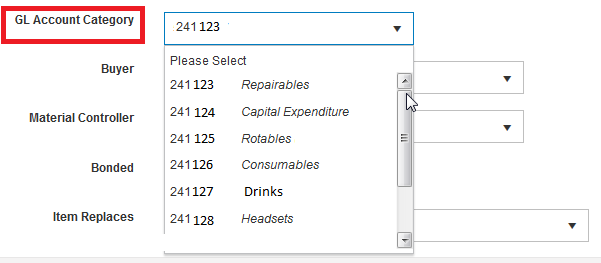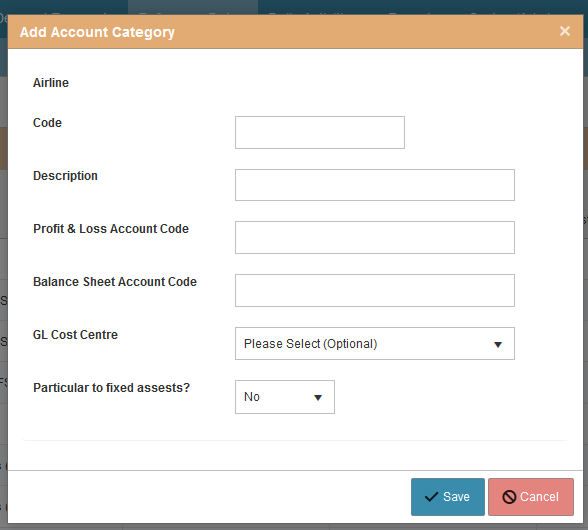Difference between revisions of "Station AccountCategoryIndex"
| (2 intermediate revisions by 2 users not shown) | |||
| Line 3: | Line 3: | ||
<h1>Creating Account Category</h1> | <h1>Creating Account Category</h1> | ||
| − | This page is only visible for Skylogistix local administrator / Skylogistix global administrator roles. You will need to create an Account category when the airline | + | This page is only visible for Skylogistix local administrator / Skylogistix global administrator roles. GL Account Categories are used when there are interfaces between SkyLog and the Airline’s financial systems. You will need to create an Account category when the airline makes changes to their GL account structure or wants to allocate items to different GL accounts. Creating Account categories is expected to be a sporadic task. It is important that when creating new account categories in SkyLog, that the linked GL accounts are already created in the Airline finance systems in order to avoid Interface issues. |
The Account categories are assigned to stock items on the drop down list of GL Account Category on the Edit stock item page. | The Account categories are assigned to stock items on the drop down list of GL Account Category on the Edit stock item page. | ||
| Line 9: | Line 9: | ||
[[File:20200414_Edit_Stock_Item.png]] | [[File:20200414_Edit_Stock_Item.png]] | ||
| − | To create a new Account Category you should take the add icon from the | + | To create a new Account Category you should take the add icon from the Account Category page. |
[[File:20200414 Add Account Categories.png]] | [[File:20200414 Add Account Categories.png]] | ||
| Line 27: | Line 27: | ||
• '''Description''' – Defined by the user, expanded information | • '''Description''' – Defined by the user, expanded information | ||
| − | • '''Profit & Loss Account code''' – | + | • '''Profit & Loss Account code''' – Refers to the GL accounting code where the expense costs should be posted. Expenses may be posted for example for consumption (based on stations inventory counts), warehouse stock adjustments and shipments losses. Normally this will be a debit posting but it could be a Credit if there is a negative consumption i.e. inventory has been gained/found |
| − | • '''Balance sheet Account code''' – | + | • '''Balance sheet Account code''' – Refers to the GL category accounting code where the inventory value should be posted. Accounting postings may include goods receipts to a warehouse, shipments from warehouse to stations, RMAs from station to station or from station to warehouse. Also when there is consumption against a location, credit postings may be done to deduct stock from the balance sheet |
| − | • '''GL Cost centre''' – This is an optional field, when all the costs are linked to | + | • '''GL Cost centre''' – This is an optional field, when all the costs are linked to a specific Cost centre. Depending on the Interfaces with the financial system it can have different purposes of use. |
| − | • '''Particular to fixed assets?''' – Most airlines consider trolleys as fixed assets, and therefore behave | + | • '''Particular to fixed assets?''' – Most airlines consider trolleys as fixed assets, and therefore behave differently from the rest of the products, in general P&L transaction types are not posted for fixed assets, only Balance sheet movements |
Once all fields have been completed, click SAVE | Once all fields have been completed, click SAVE | ||
Latest revision as of 12:03, 14 May 2020
Contents
Creating Account Category
This page is only visible for Skylogistix local administrator / Skylogistix global administrator roles. GL Account Categories are used when there are interfaces between SkyLog and the Airline’s financial systems. You will need to create an Account category when the airline makes changes to their GL account structure or wants to allocate items to different GL accounts. Creating Account categories is expected to be a sporadic task. It is important that when creating new account categories in SkyLog, that the linked GL accounts are already created in the Airline finance systems in order to avoid Interface issues.
The Account categories are assigned to stock items on the drop down list of GL Account Category on the Edit stock item page.
To create a new Account Category you should take the add icon from the Account Category page.
You will get the following pop up
Where,
• Airline: You will be presented a drop down list if your user has authorization for multiple airlines.
• Code: Defined by the user, this code will be displayed in the drop down list of GL Account Category on the Edit stock item page.
• Description – Defined by the user, expanded information
• Profit & Loss Account code – Refers to the GL accounting code where the expense costs should be posted. Expenses may be posted for example for consumption (based on stations inventory counts), warehouse stock adjustments and shipments losses. Normally this will be a debit posting but it could be a Credit if there is a negative consumption i.e. inventory has been gained/found
• Balance sheet Account code – Refers to the GL category accounting code where the inventory value should be posted. Accounting postings may include goods receipts to a warehouse, shipments from warehouse to stations, RMAs from station to station or from station to warehouse. Also when there is consumption against a location, credit postings may be done to deduct stock from the balance sheet
• GL Cost centre – This is an optional field, when all the costs are linked to a specific Cost centre. Depending on the Interfaces with the financial system it can have different purposes of use.
• Particular to fixed assets? – Most airlines consider trolleys as fixed assets, and therefore behave differently from the rest of the products, in general P&L transaction types are not posted for fixed assets, only Balance sheet movements
Once all fields have been completed, click SAVE


